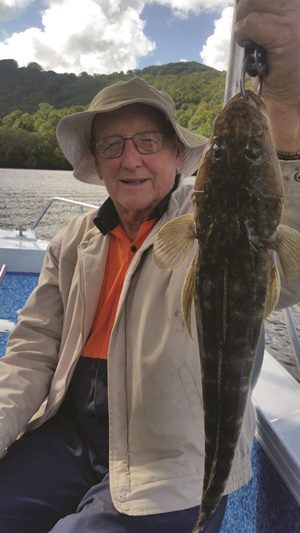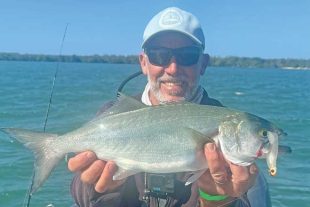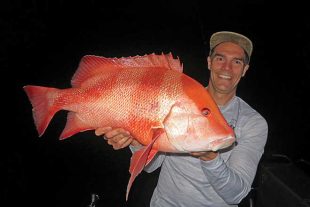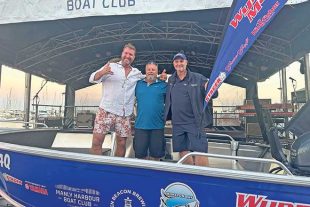


G’DAY everyone, in last month’s article we discussed locations for finding flathead and this month we will discuss options for targeting flathead with lures.
Deepwater jigging or ‘tea bagging’ soft plastics and vibes is a very effective way to target flathead in both deep holes and channels 5m and deeper. In last month’s article I shared a screenshot from my sounder of some big bait balls holding very close to the bottom in a deep hole in the Tweed River. This is the first and most important part of deepwater jigging, as the flathead will more often than not be lying in ambush under the bait schools.
Once I have located the bait, I position the boat directly over the top of it and lower the lure vertically to the bottom, waiting until my line goes slack, which indicates the lure has hit the bottom. I then close the bail arm over and lower the rod tip close to the water, hopping the lure with about a 50cm movement without winding up. When using a soft plastic or vibe, it is important to note most strikes come as the lure drops, so when you make your hop, lower the rod tip quickly to allow the lure to sink back down.
I can use this deepwater tea bagging technique in very deep water with only a small 40mm vibe. People ask how I keep the lure down deep and the trick is when I see my main line start to rise horizontally through the water column, I reverse to keep the line straight up and down. This means you must keep your motor running. I use a variation of the tea bagging technique in water under 5m deep.
I call it twerking and it involves casting the soft plastic or vibe out and drifting with the tide, introducing the same 50cm rod tip twitch, once again without winding in. Keep your rod tip movement as precise and repetitive as possible with the 50cm twitch. A good action will allow the slack in your line to take up as you drift without having to wind in, and the repetitive action ensures fish time their strikes better as well.
This technique works really well if the tide and wind allow you to drift along the edges of seagrass beds and deep channels. Time in motion is a factor with this technique because you cover more ground with the lure constantly hopping along the bottom, increasing your catch rate. As I have always said, trolling is underestimated by some anglers, but in reality can be the most successful technique because like the strategy I just mentioned, it allows you to cover a lot of ground.
Trolling involves a lot more than tying on a lure and driving all around the place, so let’s discuss it in more depth. First, you must have a small range of hard-bodied minnows that dive to different depths and you must learn explicitly how deep your lures will dive. Flathead are bottom feeders, so when trolling you must be continuously tapping the bottom to get their attention and a strike. For example, there’s no point towing a 2m-diving lure in 3m of water.
I like to position my lure about 20m behind the boat and troll as slowly as possible, which in most cases means having the motor just in gear on the slowest idle possible. Always keep your rod tip low to the water because this will help keep your lures running deep. I also try to keep the rods at right angles to the side of the boat because the rod will act as a shock absorber when you get a strike, and when possible, try to troll with the tide rather than against it.
By trolling with the tide your lures go deeper and you will be bringing your lure towards the fish as in most cases fish lay facing into the current. Well thanks for reading and I hope this article helps you catch a few flatties this winter. This is my favourite time of year to target them.
 Bush 'n Beach Fishing Magazine Location reports & tips for fishing, boating, camping, kayaking, 4WDing in Queensland and Northern NSW
Bush 'n Beach Fishing Magazine Location reports & tips for fishing, boating, camping, kayaking, 4WDing in Queensland and Northern NSW









